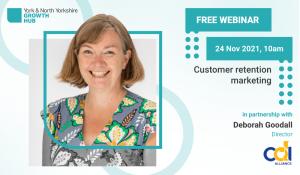
Writing a marketing plan
Creating a well-thought-out marketing plan is crucial for both reaching your target audience, and ensuring that your messaging and campaigns significantly impact your sales, fostering business growth. Below, we’ve outlined the main steps for preparing a marketing plan.
Understand your business – and your market
Before delving into the details of your marketing plan, gain a clear understanding of both your business and the market it operates in. Start by conducting a SWOT analysis (Strengths, Weaknesses, Opportunities, and Threats) to assess your business’s current position:
- Strengths: Identify what sets your business apart from competitors. Is it your product quality, your customer service, or the fact that you offer something unique?
- Weaknesses: Recognise areas where your business may be lacking or underperforming.
- Opportunities: Explore potential growth areas in the market.
- Threats: Identify external factors that could impact your business negatively.
This exercise will help set the objectives of your marketing plan and guide where to focus your efforts. It involves highlighting your product/service offer strengths, identifying opportunities for developing your customer audience, addressing weaknesses in response to negative feedback, and minimising the risk of threats.
In addition to this, you should also research your target audience (see below), competitors, and market trends to gain insights into what your customers are looking for, and what the general competitive environment is like in your industry.
Set clear marketing objectives
Once you have a thorough understanding of your business and the market, establish clear marketing objectives that align with your overall business goals. Ensure that your objectives are Specific, Measurable, Achievable, Relevant, and Time-bound (SMART). For example:
- Increase website traffic by 20% within the next six months, with a conversation rate of 2% among new visitors.
- Boost social media engagement by 15% over the next quarter.
- Generate £10,000 in monthly online sales by the end of the year, growing it as a percentage of overall sales from 15% to 20%.
Define your target audience
Knowing your target audience is fundamental to successful marketing. Use what you know about your audience to create detailed customer ‘personas’. A persona is a fictional profile that represents a group of people in your target audience. This includes demographics, interests, pain points, and consumer behaviour. This information will help you tailor your marketing efforts effectively – Hubspot have a helpful guide to get started with creating personas.
Read our guidance on how to define your target audience for more information.
Develop your marketing mix
The marketing mix consists of what marketing experts call ‘the four Ps’: Product, Price, Place, and Promotion – factors you can control to make a customer more likely to buy your product or service.
- Product: Ensure your product or service meets the needs and preferences of your target audience.
- Price: Determine the right pricing strategy based on market research and your business objectives.
- Place: Choose the appropriate distribution channels to make your product or service accessible to your audience.
- Promotion: You’ll need a comprehensive promotional strategy, including advertising, public relations, and social media and content marketing.
All four are important, but experts tend to suggest that price and product quality play the more significant roles in customer decisions.
Set your budget
Allocate a budget for your marketing activities. Consider both online and offline channels, as well as any marketing tools or platforms you intend to use. Ensure that your budget aligns with your marketing objectives and revenue projections. Find out more in our guidance on setting a marketing budget.
Choose your marketing channels
Select the marketing channels that will help you reach your target audience effectively. Think about where your audience spends their time and where they get their information. Digital marketing is highly influential, with a strong emphasis on social media advertising, email marketing, and search engine optimisation (SEO) for websites. Traditional marketing channels like print media and direct mail can also be effective depending on your audience. There is more information on marketing channels in our page about expanding your business online.
Monitor and measure
Once you put your marketing plan into action, you should also be closely monitoring the performance of your campaigns. Utilise analytics tools to measure key performance indicators (KPIs) and adjust your approach as needed to maximise spend and attention on what is working best. Read our tips on getting started with measuring your impact.
Review and adjust
Regularly review your marketing plan to assess its effectiveness. Be prepared to make adjustments based on changing market conditions, customer behaviour, and the performance of your marketing activities. Don’t be afraid to drop campaigns or approaches that aren’t working – but see what you can learn from them.
Creating a marketing plan is a critical step towards growing your sales and your business. By understanding your business, setting clear objectives, defining your target audience, and implementing a well-thought-out plan, you can increased the chances of successfully reaching and engaging more customers.
Learn more
Find out how to measure the impact of your marketing activities
Secure your place: Business Support Programmes 2024
The Growth Hub is hard at work curating a new package of business support programmes for 2024. The programmes will be available to businesses located in North Yorkshire, funded by North Yorkshire Council’s Shared Prosperity Fund.
Choosing your online marketing channels
To help you make the right choices for your business, let’s go over some of the options available to you. It’s important to consider the pros and cons for each marketing channel and whether the channel is a good fit with your target audience. Email marketing There’s often confusion about whether email is inbound or
Introducing Meld: North Yorkshire's new Business Community
Meld is a new community for people starting and running businesses in North Yorkshire. The team behind the project are building Meld to be a melting pot of ideas, support, advice, nice people and cool businesses. We hope this becomes a place you come to mix. connect. belong… and build.
Businesses given digital skills boost
Two Digital Transformation Days took place in Scarborough and Pickering, featuring expert insight from industry leaders. Hosted by York & North Yorkshire Growth Hub, around 50 businesses attended the free events. Coaches from Google Digital Garage led sessions on both days.
Digital Transformation Days Set to Empower Yorkshire Coast Businesses
Business owners and marketing managers in the Yorkshire Coast region are gearing up to take their digital offer to the next level as the York & North Yorkshire Growth Hub prepares to host two Digital Transformation Days, in collaboration with Google Digital Garage.
Business Support Programme: 1:1 Social Media Support with Catch Design
Businesses in North Yorkshire have the chance to supercharge their social media and dial up their digital marketing with fully funded 1:1 bespoke support from industry expert Sue Thompson of Catch Design Management.
How to create a profitable website and generate leads
Learn how to create a profitable website that can serve as a powerful tool to attract customers, generate leads, and increase revenue.
How to Sell Goods or Services to the Public Sector
Increase your customer base and increase revenue by learning how to successfully sell goods or services to the public sector with our expert advice.
Marketing for start-ups: A beginner’s guide
Marketing for start-ups can leave your head spinning, especially if marketing is new to you. Here’s a quick and easy guide to getting started with marketing for start-ups. How to make a plan when marketing for start-ups The best place to start with your marketing strategy as a start-up business owner is to make a
How to create free publicity as a small business
Advertising for small business can be a complex and is often one of the biggest costs you have to cover.
How to keep your business pitch simple
Like most other communication, keep your business pitch simple, informative and fun.
Customer relationship management tools
There are lots of great customer relationship management (CRM) tools out there that you could use in your business.
Fire up your Food and Drink business with Make it! toolkits
A free video toolkit to help growing food and drink businesses in York and North Yorkshire. Essential ingredients for food and drink business success.
Screen Tourism Toolkit
A free screen tourism toolkit exploring the opportunities, showing best practice and connecting business with resources and support.
2022 Seminar Recordings
We have recently hosted a programme of in-person seminars and other events, some of which were professionally recorded and can now be viewed on our website.
Seminar Recording : Access to finance: Funding growth
This workshop will provide guidance on cost based pricing, calculating your costs before deciding an appropriate margin, as well as covering market based pricing asking questions such as: What value do you add? What are you worth? How do you position yourself?
Growthbox marketing service
The York & North Yorkshire Growth Hub are working with Growthbox, who help small businesses work out what marketing to do and connect them with their growing army of marketing experts all across the UK who can help them get it done.
Cookies and privacy notices: do I need them on my website?
This webinar will cover what cookies are and what cookie law is, what a privacy notice is, the laws surrounding both, and how to ensure you are being transparent to your customers when creating a cookie policy and privacy notice.
An introduction to sales
This webinar will help you get sales confident by providing tips and guidance on mastering important communication skills.
Free Webinar : How to be a LinkedIn 'All-Star'
This webinar will explore how you can use LinkedIn as a part of your social media strategy, helping you to create connections and make an excellent first impression.
Free Webinar - Customer Retention Marketing
This webinar will provide you with practical tips to help you retain your customers and build a relationship with your audience.
Webinar: Capitalising on your social media impacts
This webinar will provide you with guidance on how to move ahead with your marketing strategies in our current climate, to ensure that you maximise on the opportunities presented by new social media trends in 2021 and beyond.
Leadership Series: Empowering your team – learning to delegate and let go
This free webinar will help leaders consider what gets in the way of delegation and how important it is to empower the team to deliver on your behalf.
Wellbeing Series: Supporting return to work
This free webinar with the University of York will introduce a return to work toolkit for managers and team members.

























